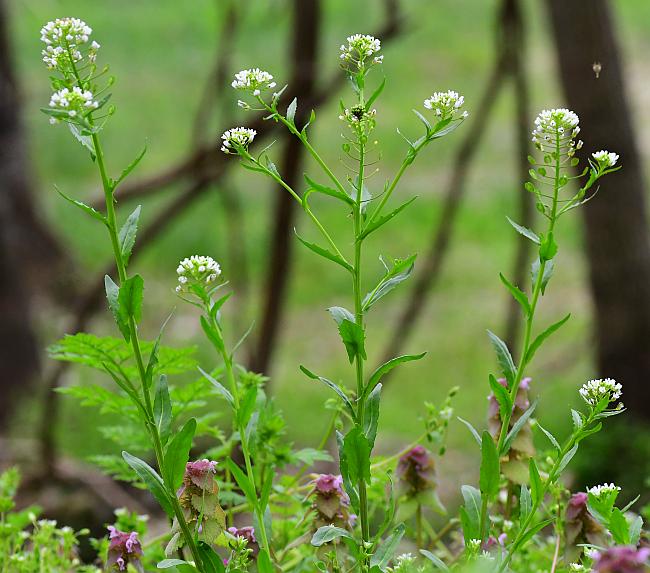Thlaspi arvense L.
Field Penny Cress

Introduced
CC = *
CW = 5
MOC = 73
© SRTurner
Thlaspi arvense L.Field Penny Cress | |
 |
Introduced CC = * CW = 5 MOC = 73 |
© SRTurner |
|
Family - Brassicaceae Habit - Annual forb with thickened roots, usually with a faint fetid odor when bruised, sometimes glaucous. Stems - Erect, to 75 cm tall, glabrous, branching above near inflorescence, ribbed.
Leaves - Basal and alternate, simple. Basal leaves in a rosette, few or absent at flowering time, spatulate, oblong, or narrowly obovate, glabrous, very shallowly toothed or lobed, to 8 cm long. Petiole winged. Stem leaves alternate, clasping, auriculate, lanceolate to lanceolate-oblong, glabrous, to 7 cm long, 2 cm broad, the margins coarsely toothed, the basal auricles pointed.
Inflorescence - Compact terminal racemes, elongating in fruit to 30 cm.
Flowers - Sepals 4, free, spreading to erect in flower, 2.0-3.0 mm long. Petals 4, white, clawed, 3-4 mm long, glabrous. Stamens 6, divided into 2 sets of 3 on either side of flattened ovary, included to equaling corolla. Styles 0.1-0.3 mm long. Pedicels to 1 cm long in flower, greatly increased in fruit.
Fruits - Silicles 8-20 mm long, broadly elliptic or obovate to nearly circular in outline, flattened, the margins broadly winged their entire length, the apical notch narrowly U-shaped and longer than deep. Seeds mostly 3-8 per locule, 1.6-2.0 mm long, broadly ellipsoid to obovoid, the surface with a series of concentric, arched ribs, dark gray to black. Pedicels to 2 cm long, glabrous.
Flowering - April - June. Habitat - Fields, pastures, lawns, roadsides, railroads, open disturbed areas. Origin - Native to Europe. Lookalikes - T. alliaceum, Lepidium campestre, Lepidium chalepense. Other info. - This is a very common and weedy inhabitant of pastures and fallow crop fields. It occurs throughout Missouri and in every state of the continental U.S., though it is uncommon in the far south. It is most easily recognized by the fruits, which are relatively large, nearly circular, and strongly flattened. The plants are usually completely glabrous, and the crushed foliage has a characteristic odor which many people find unpleasant. Dan Tenaglia remarked that the fruits have a characteristic "cabbage" flavor when chewed. The plants are edible and perhaps even palatable when young, but reportedly become very bitter after flowering. Photographs taken at the Kansas City Zoo, 5-11-00, and at Danville Conservation Area, Danville, MO., 4-1-04 and 5-3-04 (DETenaglia); also near Labadie, Franklin County, MO, 3-29-2007 and 4-17-2013, at Pacific Palisades Conservation Area, Jefferson County, MO, 4-2-2020, and along the Katy Trail near Treloar, Warren County, MO, 4-6-2020 and 4-20-2020 (SRTurner). |